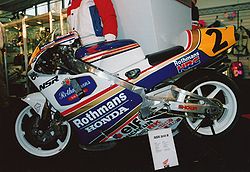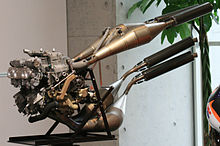- Honda NSR500
-
Honda NSR500 
Manufacturer Honda Racing Corporation Production 1984-2002 Predecessor Honda NS500 Successor Honda RC211V Engine 500 cc two-stroke V4 The Honda NSR500 is a race motorcycle from the Honda NSR series. It was created by HRC (Honda Racing Corporation) and debuted in 1984 for the Grand Prix motorcycle racing's 500 cc class. Honda won ten 500cc World Championships with the NSR500 from 1984 to present, six in a row 1994 to 1999. With more than 100 wins to its credit, the NSR500 is the most dominant force in modern Grand Prix motorcycle racing. The 1989 NSR500 that won Honda's third 500 World Championship with Eddie Lawson exemplifies the overwhelming power, acceleration and raw speed that has always been synonymous with Honda's 500 cc two-stroke V4.
Contents
1984 - 1987
Designed to succeed Honda's first two-stroke Grand Prix racer, the NS500 triple, NSR500 debuted in 1984 for the Grand Prix motorcycle racing's 500 cc class. Building on lessons learned from its three-cylinder predecessor, the new V4 used a single crankshaft, making it lighter and more compact than its dual-crankshaft adversaries. Though tormented by unorthodox chassis technology in its first season, the NSR500 evolved to clinch Honda's second 500 cc GP title in 1985. Opening the V-angle to 112 degrees in 1987 made room for a quartet of 36 mm Keihin carburetors between the cylinders where they could be fed more cool air. The new arrangement also let the engine exhale more efficiently through its four artfully intertwined expansion chambers. By year's end, Honda won a third 500 World Championship.
1988-1989
Entirely redesigned for 1988, the NSR500 got a stiffer, twin-spar aluminum chassis and various engine changes. More improvements gave the 1989 NSR500 upwards of 165 horsepower (123 kW) at 12,000 rpm — essentially doubling the output of the 1966 Honda RC181 Grand Prix four-stroke. Capable of well over 190 miles per hour (310 km/h), the 1989 bikes had more top speed and acceleration than anything else on the track. To contain all that muscle, the stiffer, twin-spar aluminum chassis used a curved, gull-wing-type swingarm to accommodate more efficient expansion chambers. The result was an unforgiving, but brutally fast, package that earned Honda a fourth 500 cc World Championship in 1989.
1990-1998
Though the 499 cc V-4 could produce more than 200 horsepower (150 kW), chassis development, sophisticated engine management and an Australian named Mick Doohan made the NSR500 a legend in the 1990s. Extensive testing in 1991 led to a new aluminum chassis patterned on the successful RVF750 endurance racer. Honda unveiled a revolutionary idea with a 1992 V4 that was timed to fire all four cylinders within 65-70 degrees of crankshaft rotation — the so-called "Big-Bang" engine. Along with a balance shaft that neutralized the single crankshaft engine's gyroscopic effects, the 1992 NSR500 was a breakthrough. Emphasizing acceleration over sheer speed, Doohan used this engine to win five of the first seven 500 Grand Prix races of 1992. Although a badly broken leg denied Doohan's bid for the 1992 World Championship, he would not be denied for long. Beginning in 1994, Doohan and the NSR500 won five consecutive 500 cc World Championships. Winning 12 of 15 races in 1997, he broke a single-season win record that was set in 1972. Combining for 54 total 500 Grand Prix wins, no man and machine in modern history had dominated the 500 World Championship so thoroughly. From around 1997, the NSR500 again featured the older "Screamer" engine in some factory racers, with Mick Doohan preferring the higher outright power of this design despite it being much more difficult to harness.
1999-2002
Constant development and ever-increasing sophistication sharpened the NSR500's edge, earning Honda two more 500 World Championships, with Àlex Crivillé in 1999 and again with Valentino Rossi in 2001. Regulations for the World Championship motorcycle road racing 500 cc class were changed drastically for the 2002 season with four-stroke engines being allowed to grow up to 990 cc and up to six cylinders. The name of the class was changed to MotoGP and was limited to race prototypes only. Because of these changes, Honda introduced the RC211V in 2002 to race alongside the NSR500. The larger displacement RC211V and other four-stroke bikes dominated the series and the NSR500 was eventually phased out of the class along with all other two-stroke motorcycles.
Championships won
Riders World Championships won with the NSR500:
- 1985 Freddie Spencer
- 1987 Wayne Gardner
- 1989 Eddie Lawson
- 1994 Mick Doohan
- 1995 Mick Doohan
- 1996 Mick Doohan
- 1997 Mick Doohan
- 1998 Mick Doohan
- 1999 Alex Criville
- 2001 Valentino Rossi
External links
- NSR500 Heritage official Honda page for heritage info on the NSR500
- History of the NSR500 from Superbike Planet
Grand Prix Motorcycles, 2000–2009 Series Manufacturer 2000s 0 1 2 3 4 5 6 7 8 9 MotoGP
500 cc
990 cc
800 ccAprilia RSW 500 RS3 Cube Ducati Desmosedici GP3/GP4/GP5/GP6 GP7/GP8/GP9 Honda NSR500 RC211V RC212V Ilmor X3 Kawasaki ZX-RR ZX-RR Suzuki RGV500 GSV-R GSV-R Team Roberts Proton KR3 Proton V5 KR211V KR212V Yamaha YZR500 YZR-M1 YZR-M1 250 cc Aprilia RSW 250 RSA 250 Honda NSR250 RS250R KTM 250 FRR Categories:- Honda motorcycles
- Grand Prix motorcycles
Wikimedia Foundation. 2010.


